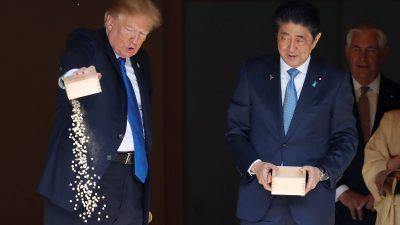Trump in Asia

It was certainly a show, but getting to the meat of it was difficult. US President Donald J. Trump, on his return from an Asian tour lasting twelve days, had set out to “correct” mistakes made by those who had come before him. The fear, however, was that he was going to make a fresh number of his own.
There was little by way of actual achievement, though the board of errors was far from stacked. Making America Great Again remains slogan, catchphrase and capturing, nothing more. Instead, there conceded reaffirmations, a grand rehash of the obvious.
“I vowed I would reaffirm old alliances and form new friendships in pursuit of shared goals. Above all I swore that in every decision, every action I would put the best interest of the American people first. Over the last 10 months travelling the globe and meeting with world leaders, that is exactly what I have done.”
The November 15 press release from the Office of the Press Secretary painted something more profound and industrious. There are bold capitals in the text, robustly insistent language on “investing in American workers”. The claim that the president personally “secured new projects and deals that will bring investment back to the United States and employ American workers” is charming in its captioned neatness.
Some specific pointers were made on “the conclusion of $12 billion in commercial agreements” with Vietnam; the announcement by South Korean companies of 64 new projects “that will invest more than $17 billion in the United States over the next four years, as well as plans to purchase $58 billion in the United States goods and services, including $23 billion in energy purchases”; and a conjured amount of $250 billion in Chinese trade and investment deals.
The greatest illusion of all, and one that will only be confirmed over time, is the notion that fair and reciprocal trade is somehow being given a push along. US deficits are being tackled with aplomb; trade surpluses being sought. The Donald is supposedly there, steering MAGA programs, and reassuring his constituents that he is “working to end years of one-sided and unbalanced trade that has left too many Americans behind.”
The South Koreans, we are assured, were encouraged to recapitulate the promise to “quickly renegotiate the US-Republic of Korea Free Trade Agreement (KORUS) and to reducing the United States’ trade deficit with the Republic of Korea”. Those in Beijing were told about “the importance of rebalancing the bilateral economic relationship” while bilateral trade language was all the rage with Vietnamese officials.
Critics back home were chewing over the usual obsessions: what did Trump really do about the North Korean situation? Had he been credible in reassuring Washington’s worried neighbours? Did he show genuine grit in discussions with President Xi Jinping of China? Things had certainly been busy on the North Korean score, and Trump and Kim Jong-un have been continuing their now regular bilateral trade in insults.
On Sunday, Trump suggested that Kim was “short and fat”, though he hoped that someday, the squabbling leaders would be friends.[1] Such are the stratospheric heights of modern nuclear diplomacy, conducted via social media.
The latest bit of spice in this encounter is an editorial from Pyongyang’s party newspaper Rodong Sinmun.
“The worst crime for which he can never be pardoned is that he dared [to] malignantly hurt the dignity of the supreme leadership. He should know that he is just a hideous criminal sentenced to death by the Korean people.”[2]
Pro-Hillary Clinton fans would find it hard to demur, and may well be nursing fantasies towards that end.
CNN, however, pondered the Trump report card on responding to North Korea with headshaking disapproval, and could only see sparse efforts: the chalking up of fresh Japanese sanctions “and a verbal commitment from China to increase pressure on North Korea.”[3]
Yet again, the press gallery was keen to see what “visible progress” had been made regarding the cessation of North Korea’s development of nuclear weapons and ballistic missiles. Given that Pyongyang’s efforts are designed to fortify its position vis-à-vis any genuine diplomatic settlement with the United States, such points are meaningless.
As for the actual progress made on the issue, the stalemate continues. Washington’s North Asian allies are perplexed and troubled, but continued insistence on the denuclearisation agenda as a start rather than an outcome persists like a nag. The focus, in the meantime, is immediately instrumental and far from constructive, with the president reaffirming “his commitment to enhance Japan’s and the Republic of Korea’s defence capabilities and to defend both countries against North Korean aggression.”
So assured, yet empty, and very much in keeping with the screening of the Trump presidential reality show.
“My fellow citizens,” he trumpeted, “America is back, and the future has never looked brighter.”
Back from where? One can only wonder in fascinated bemusement.
Dr. Binoy Kampmark was a Commonwealth Scholar at Selwyn College, Cambridge and lectures at RMIT University, Melbourne. Email: [email protected]
Notes

